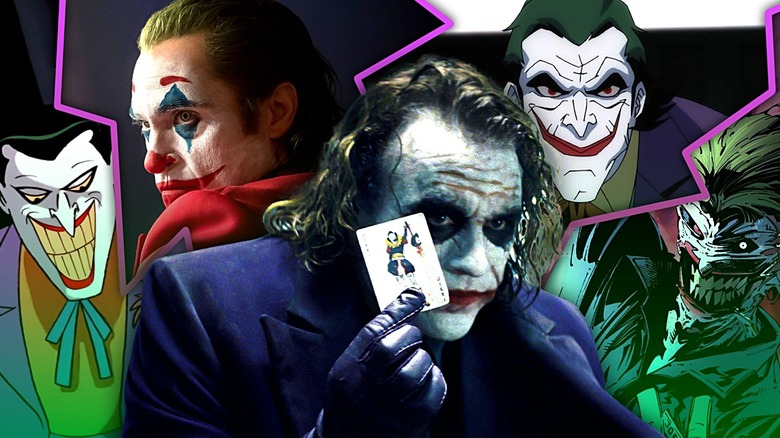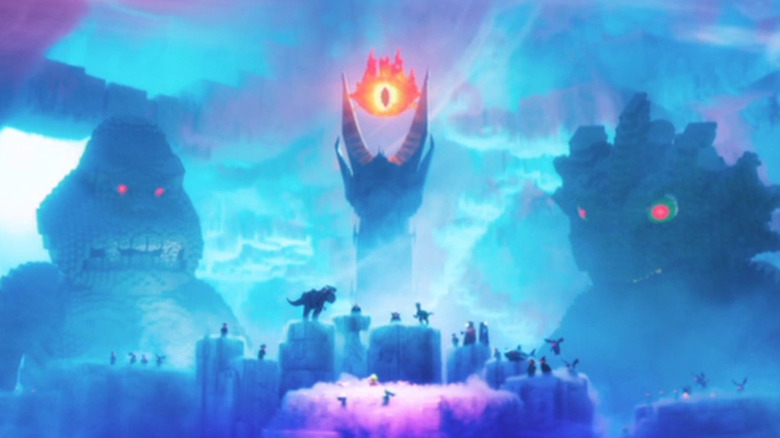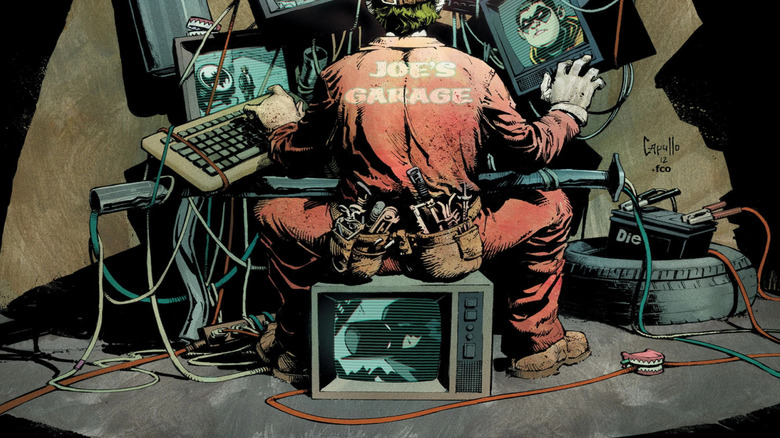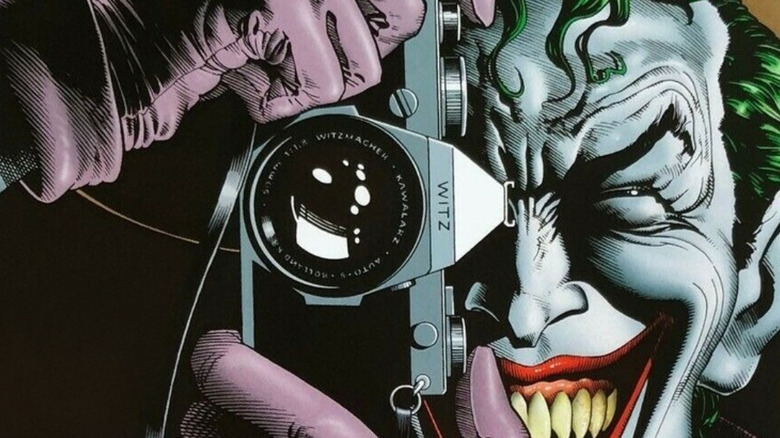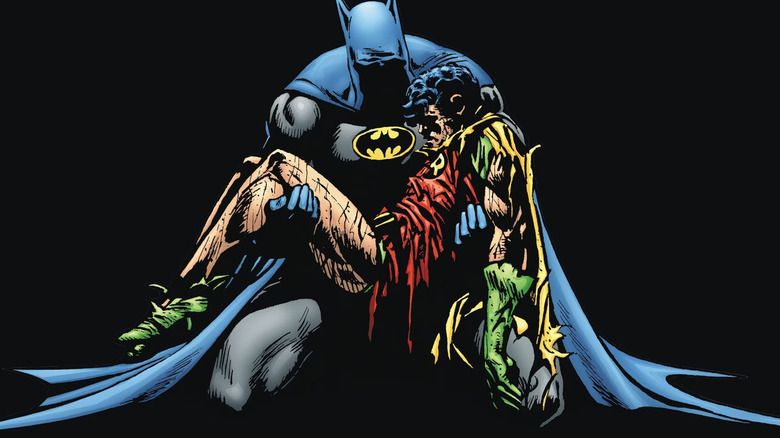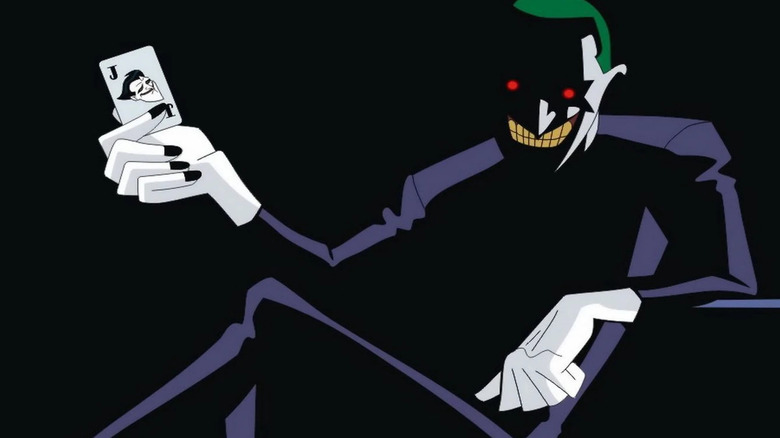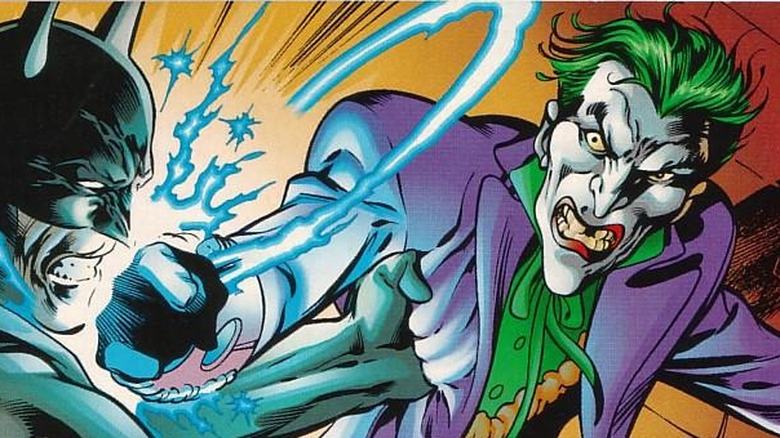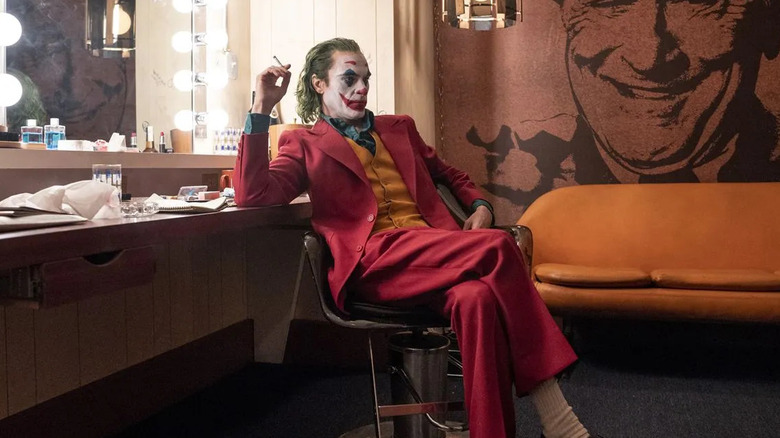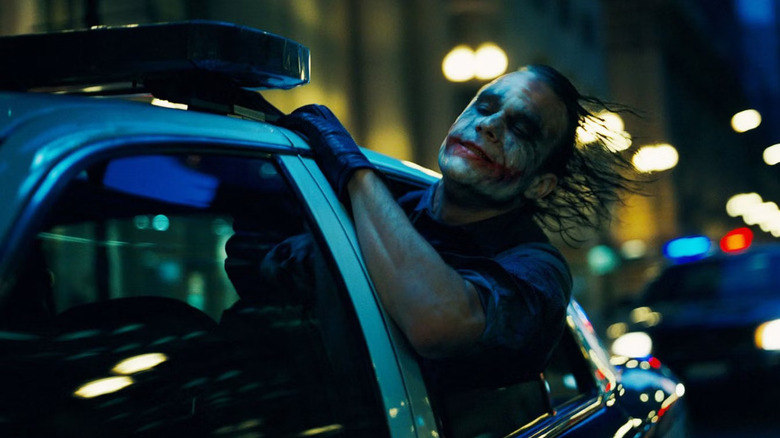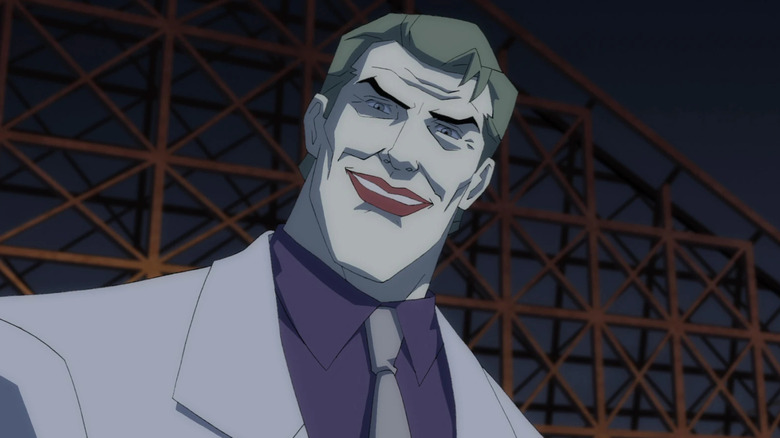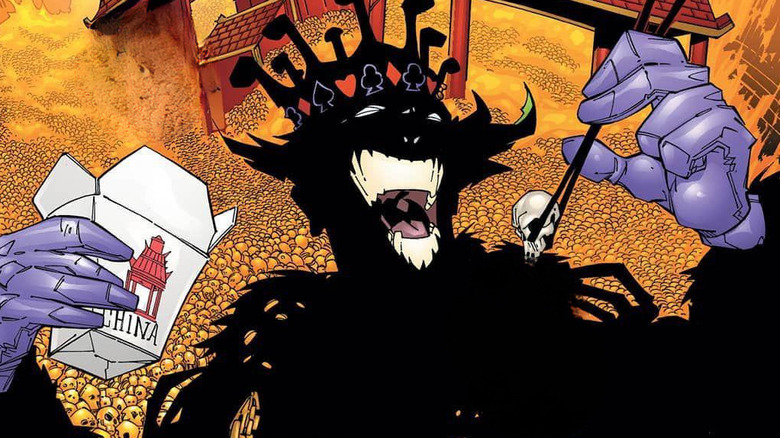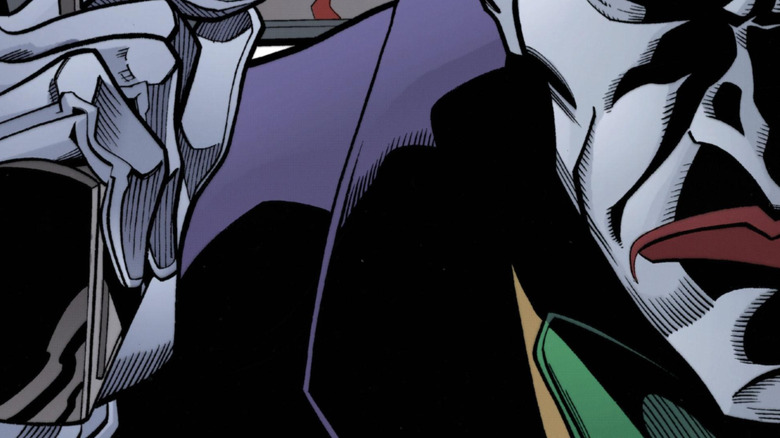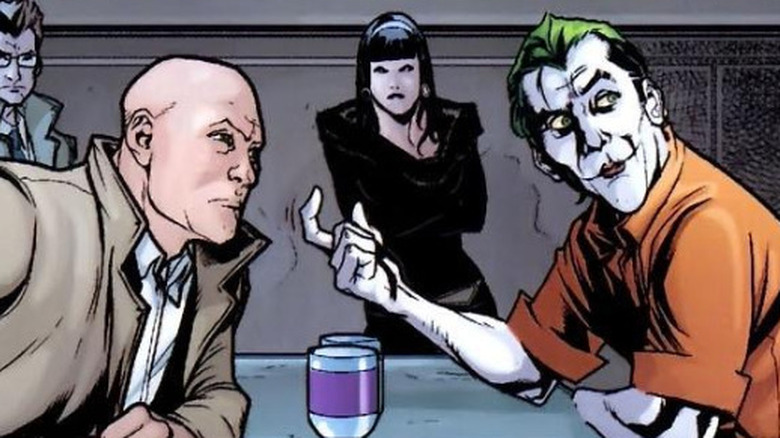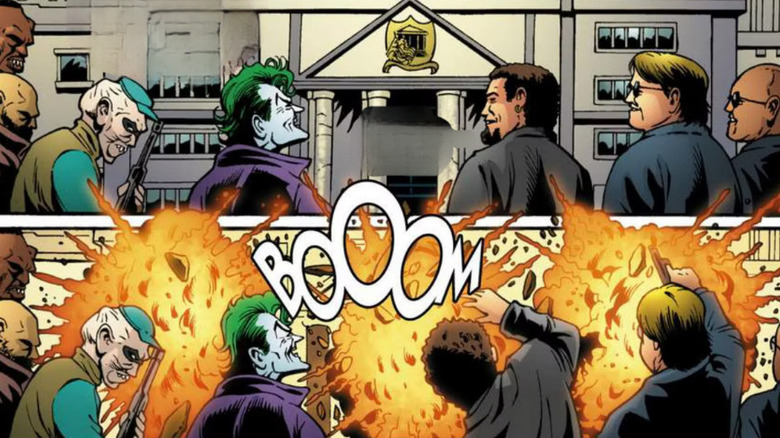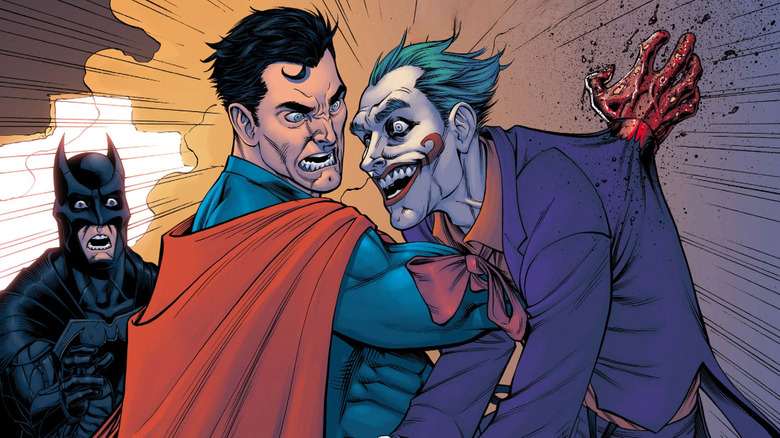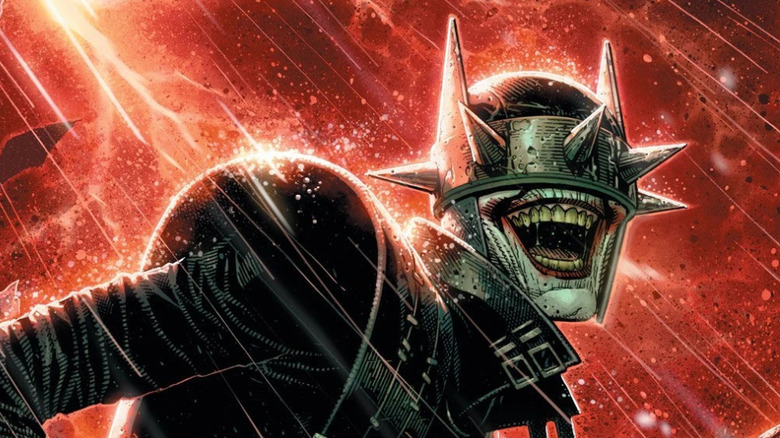The 15 Worst Things The Joker Has Ever Done
One of the most recognizable and beloved villains in the history of entertainment, the Joker has dominated the criminal underworld of DC Comics since he first appeared during the industry's Golden Age. Whether he's portrayed cartoonishly, as a maniacal mastermind of malice and mischief, or as a disturbingly plausible psychological terrorist, his appearances in "Batman" stories are consistently memorable.
What makes him so distinct is his peculiar way of carrying out his creatively heinous crimes, always with a flair for the dramatic, a smile, and a grim joke. We've gone through his history in comics, film, and television to find the most horrible things various versions of the clown prince have ever done. While we'll be avoiding some severe tonal outliers, our top 15 choices showcase the Joker at his absolute best – which is to say, his very, very worst.
Dishonorable Mention: Released every fictional villain ever from the Phantom Zone
Try as we might to assess all versions of the Joker equally, we just couldn't square where to fit the dastardly deeds of the blockhead from "The LEGO Batman Movie." Though the 2017 animated film looks as if it were made entirely out of toys, it's often considered to be one of the best "Batman" movies ever made, understanding the hero and his supporting cast better than most "serious" live action efforts. As such, we'll at least give an honorable mention to its Joker (voiced by Zach Galifianakis), and his nearly-successful plot to destroy the world.
Heartbroken by Batman's (Will Arnett) refusal to admit that he's his archnemesis, the Joker executes a master plan where he gets himself sent to Superman's (Channing Tatum) Phantom Zone so that he can free the powerful, non-DC villains trapped there like Sauron from "The Lord of the Rings" and Voldemort from "Harry Potter." Together, they successfully destroy the structural supports of the LEGO world, leading to an apocalyptic event that is only stopped when Batman convinces the Joker to help him.
Tortured the Bat-Family
Kicking off our list in earnest, we'll draw a story from the New 52 era of the DC Comics Universe: "Batman: Death of the Family." Written by Scott Snyder during his seminal run on "Batman," the event follows the Joker's re-emergence in Gotham and his plot to bring down the Bat-Family for good. The New 52 had emphasized Batman's various sidekicks in its attempts to streamline their shared continuity, with each of them leading their own series — which is all to say, there was never a better or more devastating period narratively speaking for the Joker to attack the Bat-Family as a unit.
After kidnapping and brainwashing Alfred and sending Commissioner Gordon to the hospital, the Joker kidnaps Batman, Robin (Damian Wayne), Red Robin (Tim Drake), Nightwing, Red Hood, and Batgirl (Barbara Gordon). He claims to know each of their secret identities, and organizes a dinner where he claims to be serving them their own faces (having apparently skinned them off). Though the Joker was bluffing about all of this (psychologically, he is terrified of learning any of their real names), the plot is traumatizing enough that the Bat-Family disbands indefinitely afterward.
Paralyzed and tortured Barbara Gordon
Easily the Joker's most infamous crime, the paralyzation of Barbara Gordon has long stood out as one of the darkest (perhaps unnecessarily so) moments in the history of "Batman" comics. In Alan Moore's "The Killing Joke" (a polarizing exploration of the Joker, his origins, and his relationship to Batman published in 1988), the Joker escapes Arkham Asylum and sets out to prove that anyone is merely "one bad day" away from becoming as irredeemably evil as he is.
The target of this experiment turns out to be Jim Gordon, whom the Joker hopes to warp into a broken criminal like himself. To do this, he ambushes Barbara Gordon in her home, shoots her in the stomach, and takes violating photographs of her, which he subsequently forces Jim to see. Though Barbara losing the use of her legs remains a defining (if conflicting) moment for the character among fans, Moore himself has basically disowned "The Killing Joke" as a whole as one of the worst things he ever wrote. Along with "Watchmen," in his view, it took superheroes way too seriously and perverted their intended purpose. Even so, this Joker moment is so provocative that attempts to revisit it inspire controversy decades after the fact.
Killed Jason Todd and turned him into a supervillain
A close second to Barbara Gordon in terms of victimized Bat-Children is Jason Todd, Batman's second Robin, who was murdered by the Joker as part of a bizarre viral marketing campaign for DC Comics. Having already kidnapped and brutally beaten the young boy with a crowbar (as part of a bizarre yet way less remembered storyline about the Joker teaming up with Ayatollah Khomeini), DC invited readers to call a toll-free number to help decide if Jason would live or die.
This storyline — written by Jim Starlin in 1988, the same year Barbara was paralyzed in "The Killing Joke" — helped popularize the darker tone for "Batman" stories that Tim Burton's 1989 film would cement in the popular consciousness. The story goes that Jason — being a significantly more difficult sidekick compared to Dick Grayson — was so divisive among fans that they voted for his death. Thus, the Joker left him to be blown up in a warehouse. Of course, he was later revived by Ra's al Ghul's Lazarus Pits, turning him into the jaded and unstable mass murderer Red Hood, who stars in one of the best DC animated movies.
Brainwashed Tim Drake and turned him into his successor
While the tragedies of Jason Todd and Barbara Gordon stand out as the most impactful moments in "Batman" lore, they overshadow what is arguably the best example of the Joker tormenting the Bat-Family: the corruption of Tim Drake, Batman's third Robin. As seen in "Batman Beyond: Return of the Joker" (an animated film that takes place during the events of the exceptional "Batman Beyond" series), the Joker (Mark Hamill) somehow returns to Gotham despite Bruce Wayne (Kevin Conroy) being certain that he had died years prior.
It is ultimately revealed that this new Joker is none other than Tim Drake (Dean Stockwell), whose consciousness has been overridden by a microchip implanted by the Joker when Tim held him captive as a young Robin. At the time, the Joker had tortured and brainwashed Tim into believing that he was his child. When Tim began to come to his senses, the boy killed the Joker in an act of desperation (either by pushing him into electric wires or shooting him with a flag-gun, depending on the cut you watch) — breaking Batman's one rule right before his eyes. Paul Dini, Bruce Timm, Glen Murakami, and Dan Riba took a massive swing with this Joker story, and it may be his most underrated storyline.
Tore Batman's sidekicks apart in front of him
In the 1998 elseworld story "JLA: The Nail," Alan Davis created an alternate timeline where Superman was never found by Jonathan & Martha Kent, all because of a stray nail left in the road that left them stranded with a flat tire at the wrong time. The universe that spawns from this moment is more dystopian than the mainstream DCU, but it's ot too dissimilar overall.
During this storyline, the Joker manages to free the inmates of Arkham Asylum by using gauntlets that grant him energy-based superpowers. When Batman, Batgirl, and Robin arrive to stop him, the Joker uses the gauntlets to freeze all three of them in place. Then, off-panel, he contorts their bodies and tears them apart piece by piece. Batman escapes and kills Joker soon afterward.
Killed a TV personality on live television
When Warner Bros. and DC invested millions into the massive gamble that was 2019's "Joker," they were essentially betting that the titular character could be just as compelling and terrifying as he was with Batman in his own solo movie. The bet ultimately paid off financially and, to a large extent, dramatically, as "Joker" gave longtime fans some of the character's most chilling moments yet.
Most memorably, after killing several people (including three wealthy boys in a Gotham subway car), Joaquin Phoenix's Arthur Fleck is invited onto the talk show of his personal hero Murray Franklin (Robert De Niro). As an aspiring stand-up comedian, Arthur had watched Murray nightly, and he was surprised and hurt when Murray obtained and shared a clip of him bombing at an open mic. Unmedicated and at the end of his rope, he shoots Murray point blank on live television, and then h dances his way offstage. Some may argue that this should be omitted from the list, as Arthur is implied not to be the "true" Joker (if that's even a definable title anymore) in the sequel. However, due to its shocking and memorable status within the broader, extended lore of the Joker, we feel it merits inclusion.
Corrupted Gotham City with chaos
While Joaquin Phoenix's Joker may be a pretender to the throne, Heath Ledger's Joker has long been crowned DC's king of comedy. His performance as the character in Christopher Nolan's "The Dark Knight" is arguably what's most remembered about the film as a whole, even more than actual crimes the Joker commits throughout.
The Joker's all-out assault on Gotham City is perfectly orchestrated to an almost unbelievable extent, sending a relatively normal city into the throes of chaos within the span of a few days. This is best represented by his corruption of beloved district attorney Harvey Dent (Aaron Eckhart), who becomes a murdering sociopath himself as a result. It's a psychic wound viscerally inflicted on a city of millions that we never see them fully recover from.
Killed himself to ruin Batman's legacy
Murray Franklin wasn't the first talk show host to fall victim to the Joker's schemes. In the infamous 1986 Elseworlds miniseries "The Dark Knight Returns," legendary comic book writer Frank Miller imagined a future where an aging, cynical Bruce Wayne comes out of retirement as Batman to rebel against the unchecked evil pervading his city. When he does, a once catatonic Joker immediately recovers, manages to talk his way into a spot on late night TV, and poisons the host, audience, and crew with Joker gas.
Now on the run, Joker leads Batman to an amusement park for one last dance. Batman chases him into a Tunnel of Love, where a brutal close-quarters fight sees Batman instinctively twist the Joker's neck. In the literal (and mostly accepted) read of the story, Batman merely paralyzes the Joker — who then uses what remains of his strength to contort his body enough to kill himself and leave Batman with the blame. However, it's worth mentioning that many fans believe Batman indeed killed the Joker and imagined their final conversation, with a line in the animated film adaptation potentially implying that Batman may have lost control like this in the past.
Ate everyone in China
Of all the Joker's most heinous acts, it's hard to top the tear he goes on in the story arc "Superman: Emperor Joker." In this DC comic written by Jeph Loeb in 2000, the longtime, interdimensional "Superman" foe Mr. Mxyzptlk is tricked into giving the Joker his reality warping abilities, allowing the Clown Prince of Crime to become a universal emperor with limitless power.
It's hard to even conceptualize the level of cruelty here, as Joker essentially steals the lives of everyone in the known universe by rewriting history. Even powerful figures like Darkseid and The Spectre fall to his influence. But the most horrifying thing he does, by far, is burning the entirety of the People's Republic of China to the ground, killing the entire population of the country. But that's not all, because he then proceeds to eat their skulls. Superman eventually reversed all this destruction with the help of DC's most powerful cosmic superheroes.
Killed Commissioner Gordon's wife
The same year Jeph Loeb wrote Joker as a cartoony cosmic emperor, future "Gotham Central" scribe Greg Rucka wrote a much darker story for the character. During the 2000 "No Man's Land" event (in which Gotham City is quarantined and formally disowned by the United States for essentially being too annoying to deal with), the Joker takes advantage of the chaos and kidnaps all of the newborn babies in the city, stringing some of them up like ornaments on a Christmas tree.
Eventually, Sarah Essen (a GCPD detective married to Jim Gordon) finally tracks him down and has him dead to rights at the wrong end of her service weapon. The Joker outsmarts her by tossing one of the babies her way, forcing her to drop the gun. He takes advantage of the opening, executes her, then leaves her bleeding corpse for the babies to crawl all over. When the Joker is finally apprehended and confronted by Gordon, the commissioner shows some restraint and shoots him in the leg. Understanding that he may be unable to walk again — just like Barbara — the Joker actually laughs and compliments Gordon's sense of humor.
Turned a baby into soup
If that sounds like the worst thing the Joker has ever done to a baby... we have horrible news for you. In the 2011 "Action Comics" storyline "The Black Ring" written by Paul Cornell, Lex Luthor hunts for the titular power source (after having gotten addicted to the Orange Lantern ring he obtained during the preceding "Blackest Night" event).
As part of his mission, Lex is forced to interrogate the Joker in Arkham Asylum. Among several taunts, misdirects, and non-sequiturs seemingly meant to annoy the multi-billionaire, the Joker reveals that he once tortured a man by boiling his infant child "into a soup," which he then force fed to the father. Though we fortunately never see this happen, there's no reason to doubt the story is true — though that's still not the full extent of his crimes against children.
Blew up a school of children
In 2009, writer and filmmaker Kevin Smith (of "Clerks" and "Dogma" fame) wrote his own exploration of the destructive dynamic between Batman and Joker in the three-issue comic book miniseries "Batman: Cacophony." In it, the supervillain Onomatopoeia helps the Joker escape prison so that the ensuing chaos will draw out vigilantes like Batman for him to kill.
As part of his rampage, the Joker blows up a school full of children, most of whom presumably die. Similar to "Emperor Joker," the moment is treated as one of danger in a campy comic book rather than the serious tragedy it is. It does compel Jim Gordon to ask Batman to let the Joker die by allowing him to bleed out from a knife wound he receives later on (Batman refuses, of course, which may be Smith's cheeky nod at the logic of Christopher Nolan's "Batman Begins").
Brainwashed Harley Quinn
The Joker's most consistent act of evil is arguably his psychological and physical abuse of Harleen Quinzel, better known as Harley Quinn. Though his origin always changes, their origin as a couple is almost always the same: Once a skilled psychologist working to better understand and potentially reform the mentally ill criminals of Arkham Asylum, Harleen was emotionally manipulated by the Joker into becoming his sidekick and girlfriend. After escaping Arkham, this relationship quickly entered a cycle of abuse and psychological brainwashing, with Harley losing her sanity and identity in the process.
The specific nature of Joker's mistreatment of Harley varies wildly story to story and ranges in tone from cartoonish and in some ways comical to outright unspeakable. Films like "Suicide Squad" (2016), "Birds of Prey," and "Joker: Folie à Deux" have tried to depict this dynamic in a more serious way, but we'd argue the best non-comic exploration of the Joker and Harley Quinn is in the HBO animated series "Harley Quinn."
Defeated Superman and nuked Metropolis
When the video game "Injustice: Gods Among Us" begins, gamers are only let in on the edges of the Joker's successful plot to destroy Metropolis. It wasn't until Tom Taylor's "Injustice: Year One" comic book tie-in series that the full, horrible scope of his crime was revealed.
Bored of his fights with Batman and enticed by Superman's apparently incorruptible nature, the Joker executes a plan to bring about the Man of Steel's own "one bad day." He kidnaps a pregnant Lois Lane and connects a nuclear bomb to her heartbeat, then doses Superman with a kryptonite-infused version of the Scarecrow's fear toxin. As a result, Superman believes he is being attacked by Doomsday and flies his foe into space — only to realize too late that the battle was a hallucination, and he has in fact killed Lois and sentenced Metropolis to certain nuclear destruction. In the aftermath, Superman kills the Joker in custody and rebels against Batman's non-lethal methods, establishing himself as a violent global dictator in the process.
Created the Batman Who Laughs
If there's one unstable Gotham citizen more dangerous than the Joker, it's Batman himself — a theory proved by Scott Snyder's "Dark Knights: Metal" event. The 2017 mega crossover event saw the world terrorized by evil versions of Bruce Wayne from various doom dimensions within the so-called dark multiverse.
The worst of them is the Batman Who Laughs, a version of Bruce created by an alternate version of the Joker. After that Batman was baited into executing his archnemesis, the Joker's corpse released a variant of his toxin that corrupted Bruce, who subsequently succumbed to madness and began slaughtering his closest friends and allies in the most horrific ways possible. Though indirect, this Joker's final act (masterfully triggered by Batman's momentary moral weakness) not only destroyed his greatest foes from within, but it brought about the widespread universal chaos he always dreamed of.
